AS Level Biology Hard Qs
1/49
There's no tags or description
Looks like no tags are added yet.
Name | Mastery | Learn | Test | Matching | Spaced |
|---|
No study sessions yet.
50 Terms
Outline the steps in the production of monoclonal antibodies by the hybridoma method. [3]
Small mammals (such as mice) are injected with the antigen.
Immune response in them occurs over several weaks;
Plasma cells / B-lymphocytes / B-cells / splenocytes are extracted from the spleen of the test subject;
Plasma cells are fused with myeloma/tumour/cancer cells to form hybridoma cells;
Hybridoma cells are separated into wells and they produce clones;
Hybridoma cells are screened and those with production of desired Mabs are selected.
Antibodies can be collected from human blood donors and used to treat people that may have been infected with a pathogen. This prevents them becoming ill with the disease.
Explain why this treatment does not prevent people becoming ill if they are infected again with the same pathogen. [4]
Explain why triglycerides are not suitable as a component of cell surface membranes. [2]
Suggest why large outbreaks of cholera occurred in the countries listed in Table 5.1, but there were very few cases in most other countries.
Glucose molecules enter the cell through a membrane protein. Suggest why glucose molecules need to be cotransported with Na+ when it enters the cell through the membrane protein. [2]
Glucose molecules require cotransport with Na+ to utilize the sodium gradient established by the Na+/K+ pump. This process allows glucose to move against its concentration gradient into the cell, as the energy from Na+ moving down its gradient drives the uptake of glucose.
Suggest and explain the importance of mitosis by stem cells in the small intestine. [4]
How does high pCO2 decrease the affinity of Hb to O2? (i.e. what is the Bohr effect?) [7]
CO2 + H2O ⇌ H2CO3 ⇌ HCO3- + H+
CO2 from respiring tissues enters blood plasma and RBCs
Carbonic anhydrase in cytoplasm of the RBCs converts CO2 to H2CO3 (carbonic acid)
This maintains a steep concentration gradient for diffusion of CO2 from tissues to blood.
H2CO3 dissociates into HCO3- and H+
This decreases the pH
HCO3- diffuses out of the RBC and enters blood plasma.
Cl- moves in to balance out the negative charge (chloride shift).
H+ ion combines with Hb to form Haemoglobonic acid (HHb).
Hb now has higher affinity for H+ than for O2
HHB prevents pH from decreasing — acts as a buffer.
Hb releases oxygen.
What affects Km and Vmax? [4]
Competitive inhibitors: Same Vmax; increased Km
Non-competitive inhibitors: Lower Vmax; same Km
How are enzymes immobilised? [3]
Enzyme is mixed with a solution of sodium alginate and droplets of this mixture are added to calcium chloride (CaCl2). A reaction occurs which forms jelly/beads, enzyme is immobilised in the bead.
What are the advantages of immobilising enzymes? [5]
Enzyme is reused
Enzyme is easily recovered
Product isn’t contaminated with enzymes
Reduces product inhibition
Enzyme is more stable / less likely to denature
Longer shelf-life of enzyme
What mode of transport uses energy? [1]
Active transport only.
Explain how companion cells are involved in the transfer of sucrose into phloem sieve tubes. [4]

Outline how hydrogen bonding is involved in water transport in the xylem of a plant stem. [3]

Mucin strands are transported out of the goblet cells and then absorb water to form mucus.
Suggest and explain how mucin strands are transported out of the goblet cells. [3]
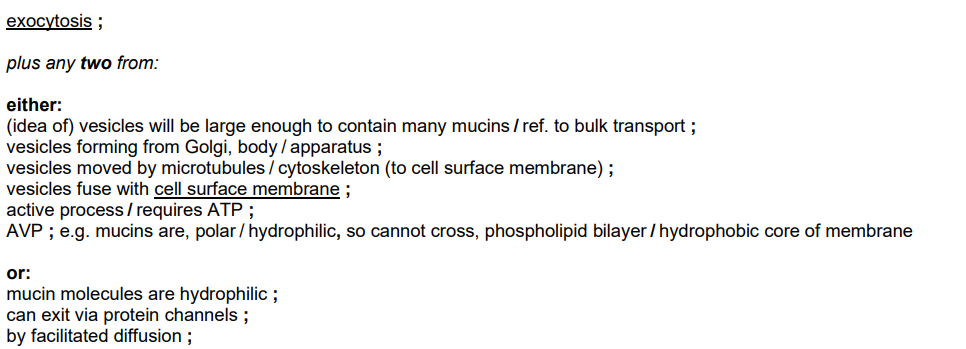
Explain how the structure of a collagen fibre provides the skin with strength. [3]

Some of the vesicles formed by the Golgi body pass to the vacuole. These vesicles contain proteins that have been folded correctly and some that have not folded into their correct shapes. The proteins that have not folded correctly pass to the vacuole where they are broken down.
Explain how proteins that have not folded correctly are broken down in the vacuole. [3]

Describe the role of lysosomes in animal cells in defence against pathogens. [2]
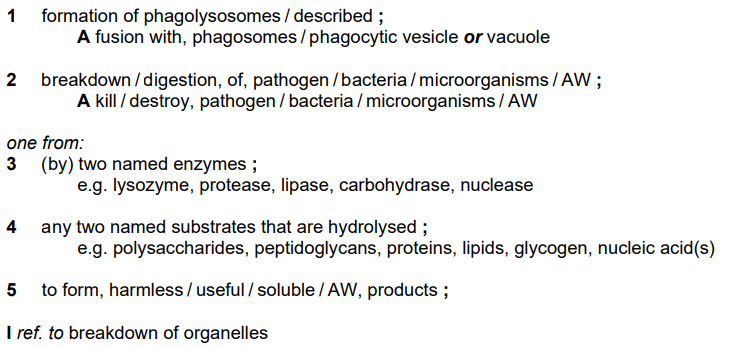
![<p>Explain how the structure of glycogen is related to its function in cells. <strong>[3]</strong></p>](https://knowt-user-attachments.s3.amazonaws.com/f43fb75b-c05f-4864-b7a0-5b220889cd82.png)
Explain how the structure of glycogen is related to its function in cells. [3]
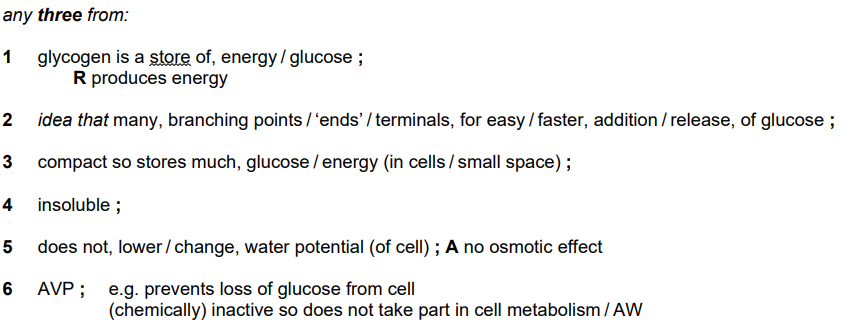
Explain how the arrangement of cellulose molecules in plant cell walls is related to their function. [3]
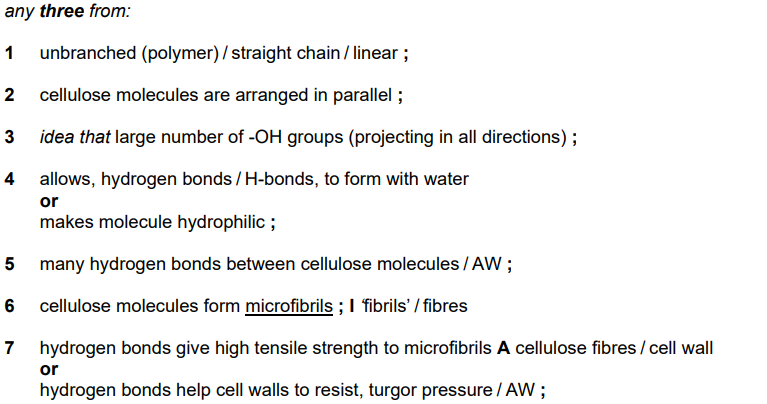
![<p>Fig. 3.3 is a diagram of a protein in the cell surface membrane of a macrophage from a mouse. </p><p>Macrophages use these proteins in antigen presentation. Non-self antigens bind to the proteins and are involved in the activation of specific T-lymphocytes during the immune response.</p><p>Some pathogens enter human cells. Macrophages partially digest these pathogens and present antigens to T-lymphocytes during immune responses. </p><p>With reference to Fig. 3.3, explain how T-lymphocytes respond to infection by a specific type of pathogen. <strong>[4]</strong></p>](https://knowt-user-attachments.s3.amazonaws.com/453e7556-ccf0-405d-8839-550a3085eac0.png)
Fig. 3.3 is a diagram of a protein in the cell surface membrane of a macrophage from a mouse.
Macrophages use these proteins in antigen presentation. Non-self antigens bind to the proteins and are involved in the activation of specific T-lymphocytes during the immune response.
Some pathogens enter human cells. Macrophages partially digest these pathogens and present antigens to T-lymphocytes during immune responses.
With reference to Fig. 3.3, explain how T-lymphocytes respond to infection by a specific type of pathogen. [4]
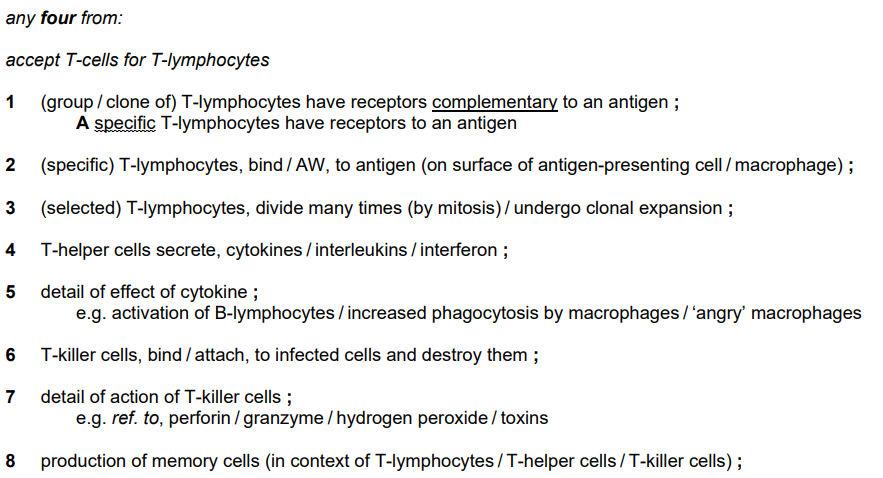
Describe the roles of DNA polymerase and DNA ligase in the replication of DNA. [5]
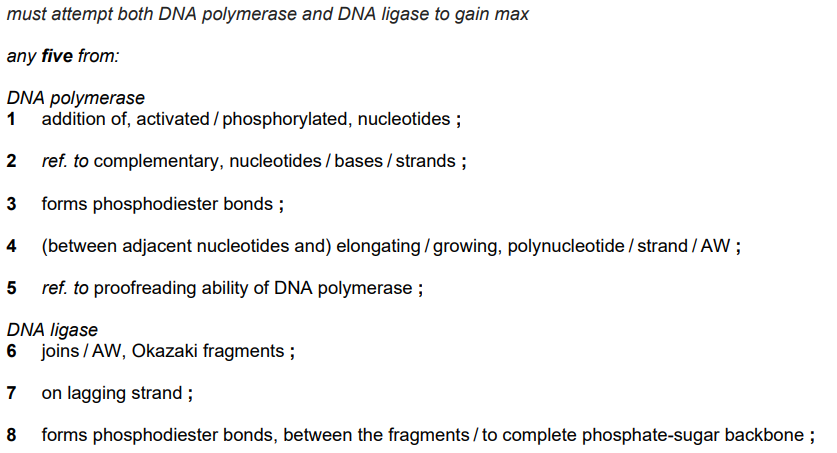
![<p>Fig. 5.2 is a diagram showing some of the events that occur as blood flows through a capillary in a respiring tissue.</p><p>An increase in respiration results in an increase in the carbon dioxide concentration in the blood and the release of more oxygen from red blood cells to tissues.</p><p>Explain how an increase in carbon dioxide in the blood leads to the release of more oxygen from red blood cells. <strong>[4]</strong></p>](https://knowt-user-attachments.s3.amazonaws.com/c0b93278-e839-4a39-bb34-84e21ebd12a1.png)
Fig. 5.2 is a diagram showing some of the events that occur as blood flows through a capillary in a respiring tissue.
An increase in respiration results in an increase in the carbon dioxide concentration in the blood and the release of more oxygen from red blood cells to tissues.
Explain how an increase in carbon dioxide in the blood leads to the release of more oxygen from red blood cells. [4]
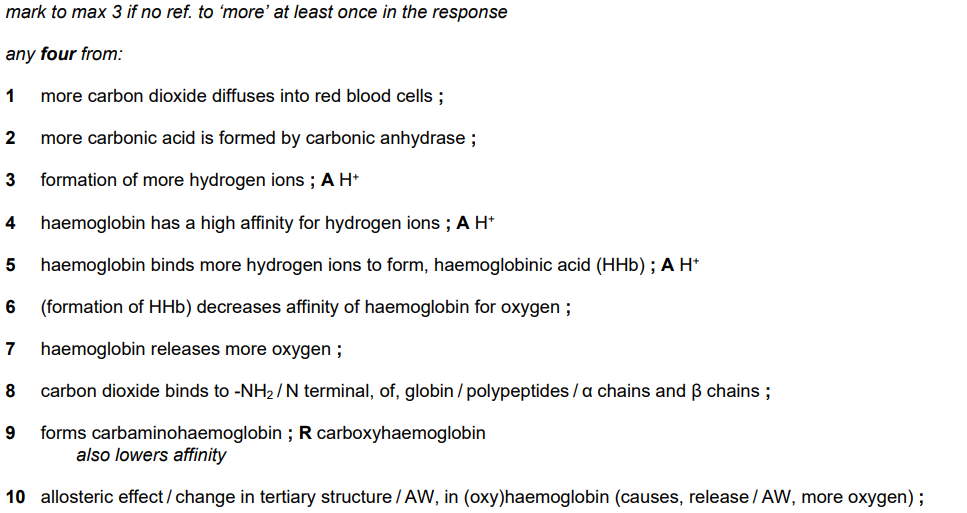
Outline the features of non-self antigens. [3]
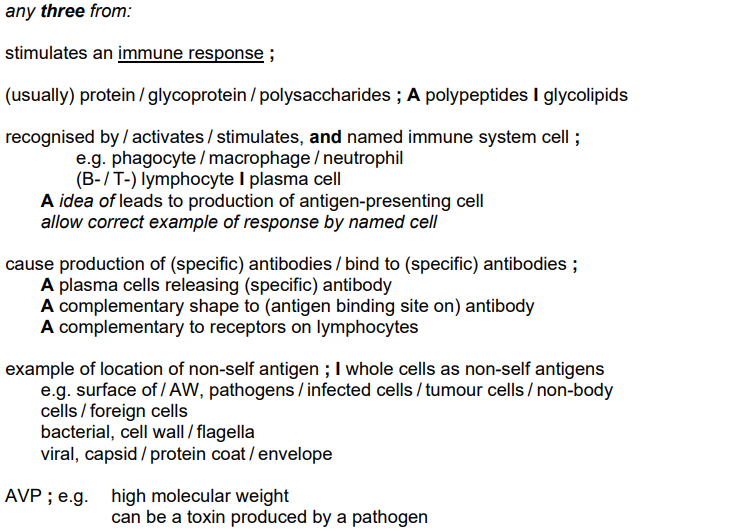
Trypanosoma brucei is a unicellular organism that causes the infectious disease known as sleeping sickness. Insects known as tsetse flies pass on the organism from infected people to uninfected people when male and female tsetse flies feed on human blood.
Outline the similarities and differences between the modes of transmission of malaria and sleeping sickness. [3]

Describe the behaviour of the chromosomes in anaphase. [3]
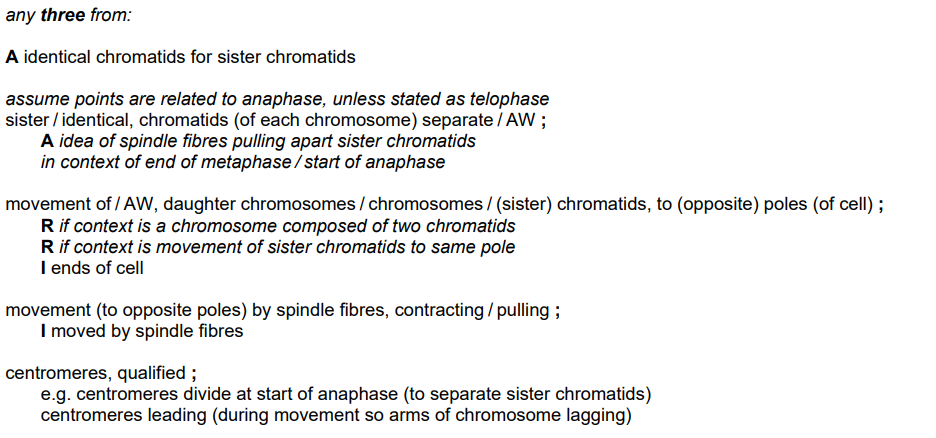
Some people with a long lifespan have cells showing a higher than normal activity of telomerase.
Suggest why a long lifespan could result from a higher telomerase activity [2]
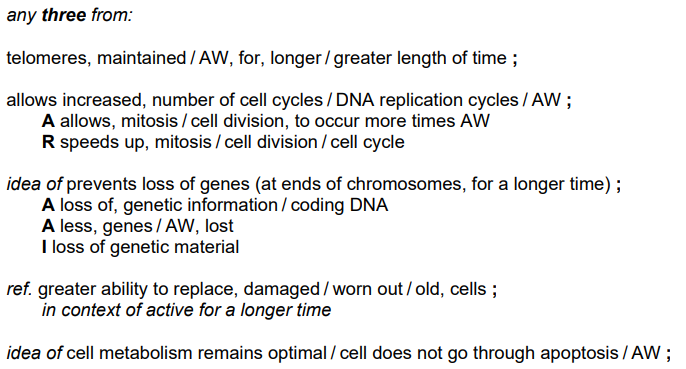
The presence of gliadin causes the immune system of a person with coeliac disease to respond by producing anti-gliadin antibodies.
Describe the sequence of events that results in the immune system producing antigliadin antibodies. [4]
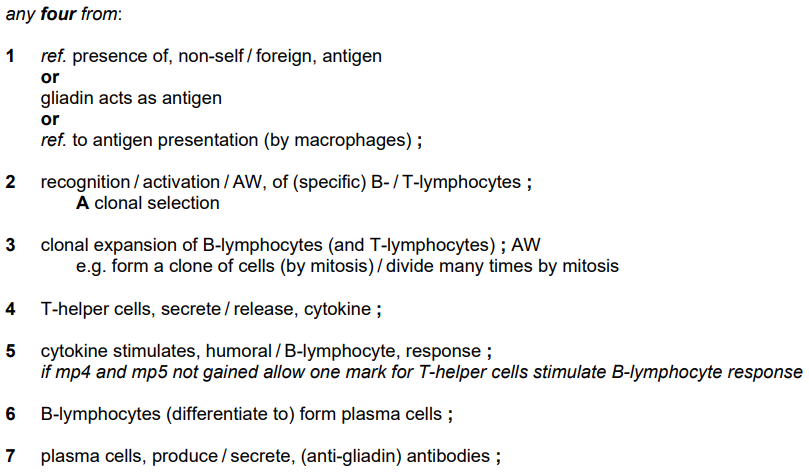
Describe how sucrose is transported in phloem sieve tubes from photosynthesising leaves to other parts of the plant. [4]
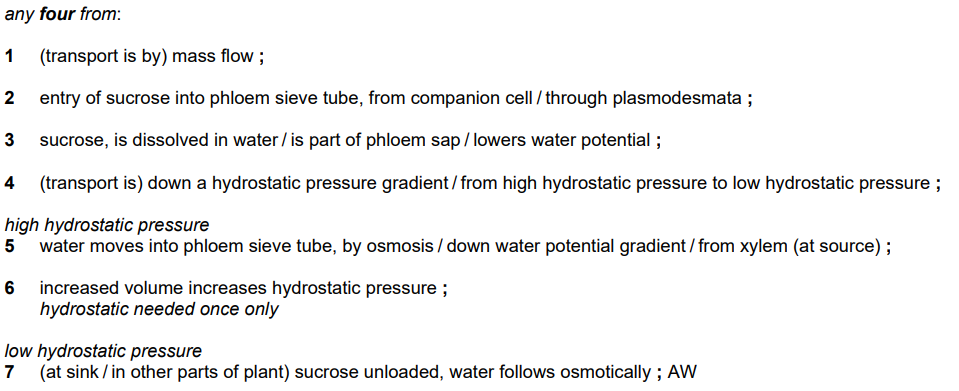
Describe the roles of the rough endoplasmic reticulum and the Golgi body in synthesising glycoproteins. [4]
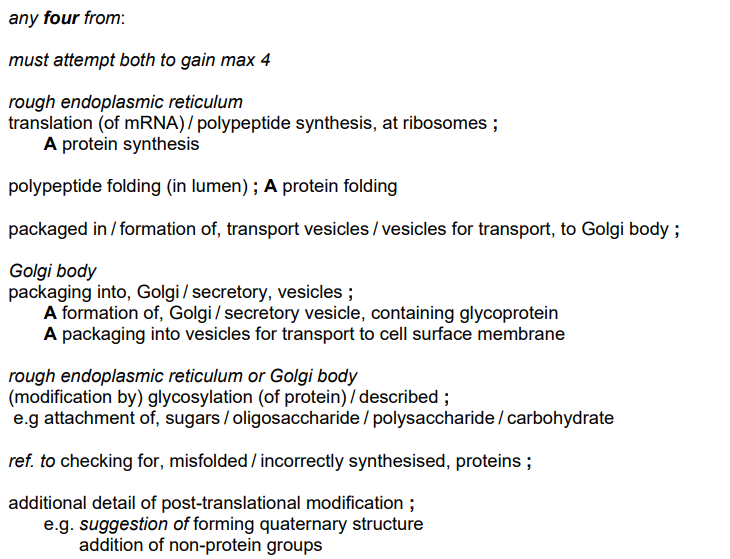
Water that has travelled through xylem vessels reaches the leaves. Cooling of the leaf occurs as a result of the evaporation of water during transpiration.
Water has a high latent heat of vapourisation because water molecules form hydrogen bonds.
With reference to hydrogen bonding, suggest why cooling of the leaf occurs as a result of evaporation of water during transpiration. [2]

People who develop HIV/AIDS have fewer T-helper cells as the pathogen destroys these cells. This makes them more susceptible to tuberculosis (TB).
Explain why people with HIV/AIDS are more likely to develop TB. [4]
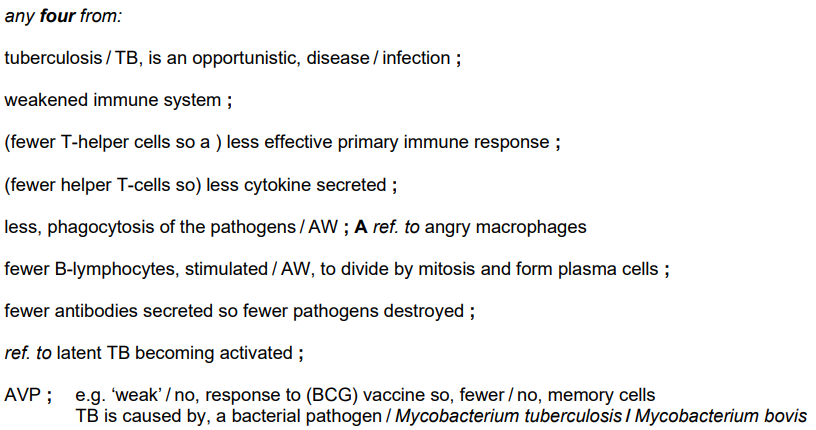
Describe the function of smooth muscle in the bronchus. [2]

Outline the changes that occur to the structure and behaviour of a chromosome:
from the start of the S phase to the end of interphase
during prophase of mitosis.
[3]
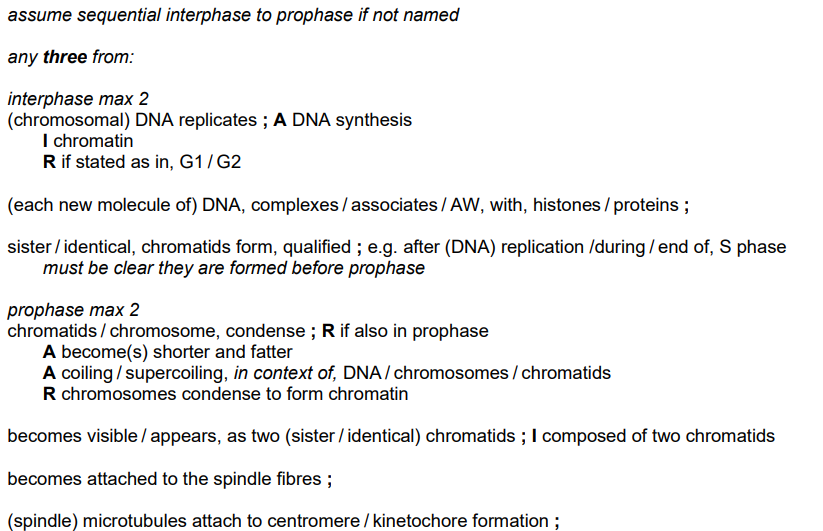
Protease enzymes hydrolyse proteins. Many proteases are able to hydrolyse more than one type of protein.
Suggest why it is possible for a protease to act on different types of protein. [1]
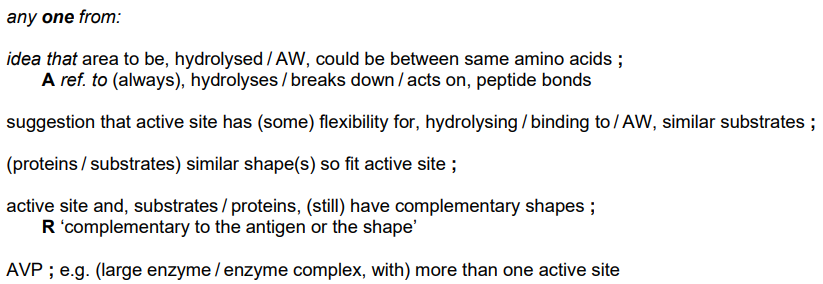
Keratin is the structural protein in feathers of birds. Keratin polypeptides are composed of a high proportion of cysteine amino acids, which have sulfur-containing R groups. Keratin polypeptides form filaments. The two main types of keratin in feathers are α-keratin, which consists of many α-helices, and β-keratin, consisting of many β-pleated sheets.
Proteases known as keratinases vary in the extent to which they can hydrolyse keratin.
Feathers are not easily degraded (broken down) because keratin is a very stable protein.
Suggest features of keratin structure that contribute to its stability [3]
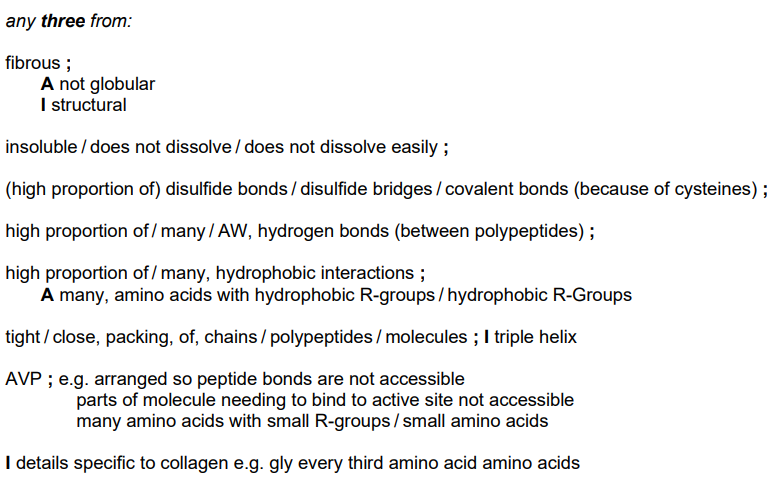
In addition to removing bacteria present in the blood inside the sinusoid, Kupffer cells are also able to remove old or damaged red blood cells. Describe the mode of action of a Kupffer cell in removing and breaking down a damaged red blood cell. [4]
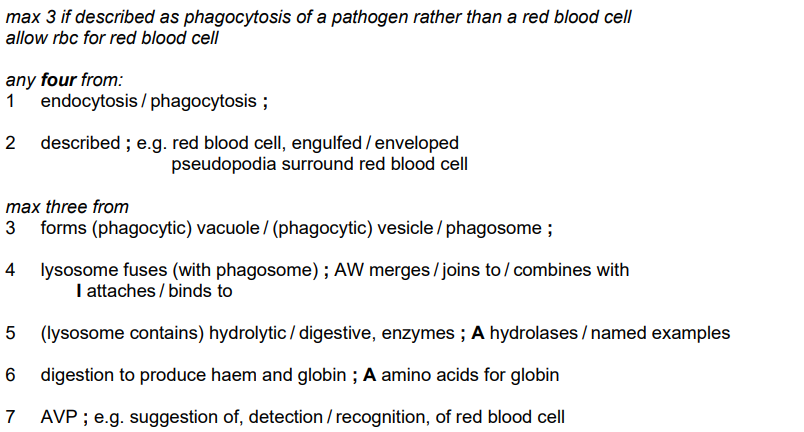
Explain how blood flow through the alveolar capillaries helps to maintain steep diffusion gradients for gas exchange. [2]

Ventilation of the lungs is the process of inhalation and exhalation. Ventilation helps to maintain steep diffusion gradients.
Explain the role of elastic fibres in the alveolar wall during ventilation [3]

In some areas, cattle cannot be regularly tested or treated for TB. In these areas, milk and dairy products from infected dairy cattle may enter the human food chain.
Outline a control measure that can be taken to protect people that consume milk and dairy products from these infected cattle. [1]

Outline the treatment that is used to kill M. tuberculosis in latent TB infections. [2]

M. tuberculosis can spread in the blood and lymph to other organs in the body.
In very rare cases, a disease known as mycotic aneurysm can be caused by infection of the arterial wall, particularly in elastic arteries. The damage caused by the pathogen can lead to a rupture (bursting) of the artery.
With reference to the structure of the wall of elastic arteries, suggest how damage caused by M. tuberculosis infection can lead to the rupture of the artery.
You may draw a diagram if you wish.
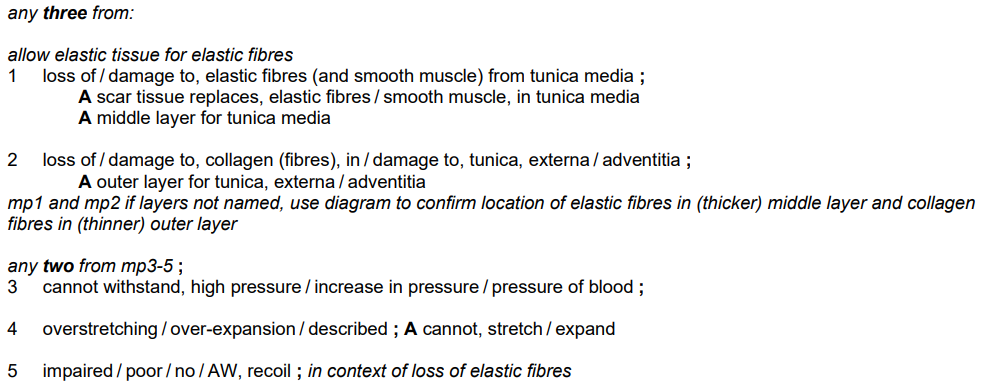
The walls of the cells forming the xylem vessel walls become lignified during development.
Explain how this feature is important for the efficient transport of water [2]

Explain how antibodies will reduce the spread of the malarial pathogen through the bloodstream. [3]
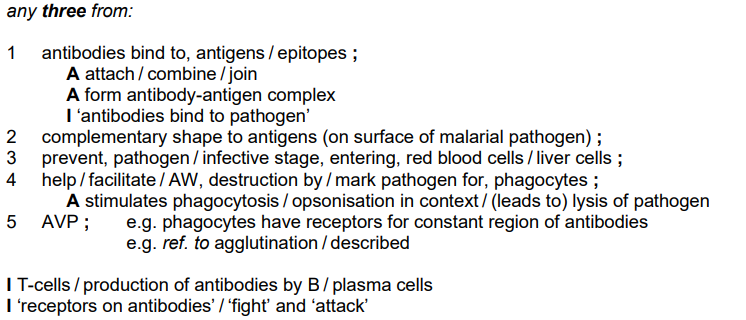
Some vaccination programmes have been more successful than others.
Discuss the factors that contribute to the success of a vaccination programme. [5]
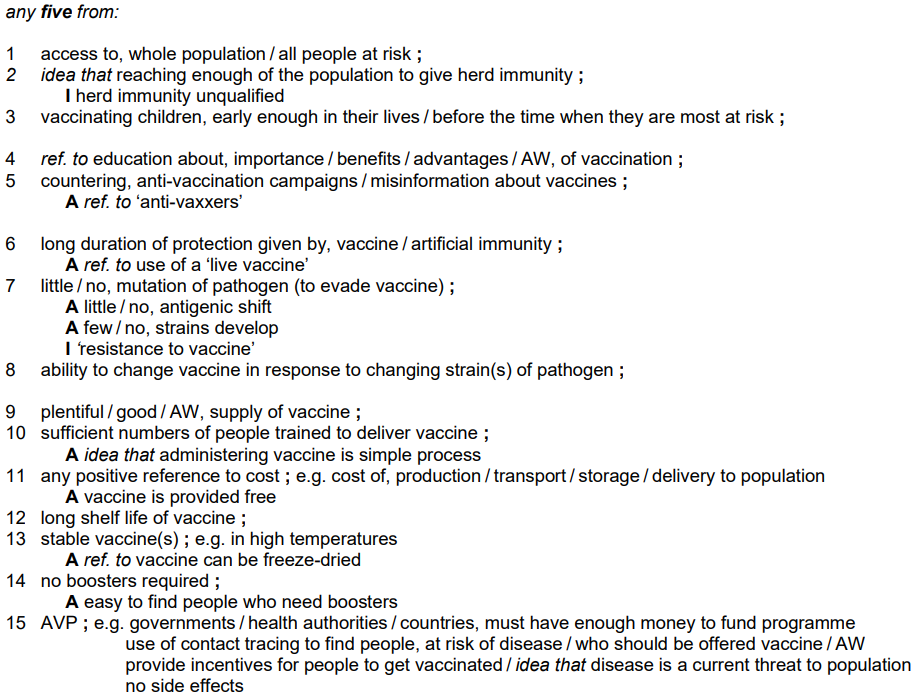
Haemoglobin is involved in the transport of carbon dioxide.
Molecules of carbon dioxide enter red blood cells as the cells travel in capillaries through muscle tissue. Some of these molecules are converted to carbonic acid.
Explain how haemoglobin is involved in the transport of carbon dioxide molecules that are not converted to carbonic acid. [3]

![<p>Fig. 4.1 is a diagram showing the transcription of part of the <em>COL1A2</em> gene that codes for a collagen polypeptide. The part of the <em>COL1A2</em> gene shown is a section of exon. Structure <strong>A</strong> represents an enzyme involved in transcription.</p><p>Use the information in Fig. 4.1 to explain why one of the strands of DNA is not transcribed. <strong>[2]</strong></p>](https://knowt-user-attachments.s3.amazonaws.com/d4bfb8cd-ebb9-4f2d-951e-7ce678f297ac.png)
Fig. 4.1 is a diagram showing the transcription of part of the COL1A2 gene that codes for a collagen polypeptide. The part of the COL1A2 gene shown is a section of exon. Structure A represents an enzyme involved in transcription.
Use the information in Fig. 4.1 to explain why one of the strands of DNA is not transcribed. [2]

Mitochondrial DNA codes for some polypeptides of proteins used within the mitochondrion. Some of the proteins allow movement of ions into and out of the mitochondria.
Outline the ways in which ions can move into mitochondria. [3]

Explain why a root can be a source and a sink. [2]

Describe and explain the mechanism that is responsible for the movement of phloem sap in sieve tubes. [4]
